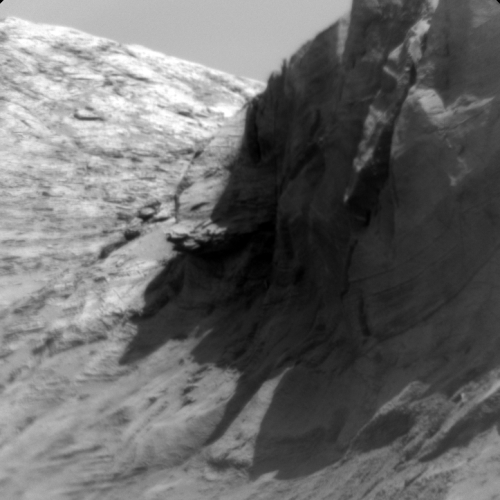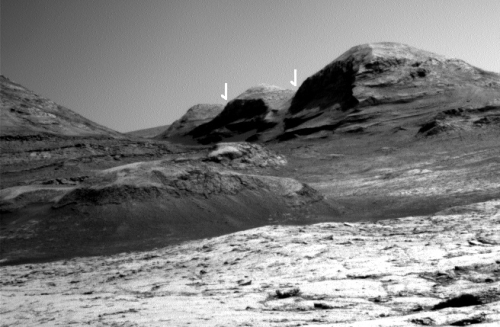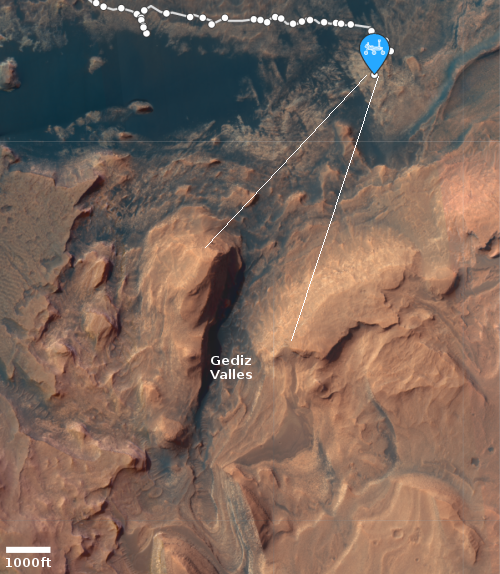The big cliffs of Gediz Vallis on Mars
Cool image time! The photo to the right, cropped and reduced to post here, was taken on May 21, 2021 by Curiosity’s chemistry camera (ChemCam), normally designed to look at high resolution close-up imagery of nearby objects.
However, it can also be used as what the science team call “a long distance spyglass.” The image to the right is an example, looking at what I think are the distant but steadily approaching big cliffs on the western wall of the canyon Gediz Vallis. Make sure you look close at the shadowed cliff-face, probably several hundred feet high. It is filled with huge rock faces reminiscent of the most stark rock cliffs on the mountains of Earth.
The two images below provide the context, which makes the image even more quite breath-taking.
The first photo to the right, cropped and reduced to post here, was taken by Curiosity’s right navigation camera of these mountains. I think the close-up above is of one of the two nooks indicated by the white arrows. The canyon cutting into the mountain is dubbed Gediz Vallis. Curiosity will eventually be inside this canyon, though to get there the present plan is to circle around the backside of the mountains on the right.
The map shows Curiosity’s position as of about a week ago, with the white lines indicating the approximate view seen in the navigation camera’s image.
As Scott Guzewich, Atmospheric Scientist at NASA’s Goddard Space Flight Center, noted in today’s update on the rover’s blog,
We’re always looking ahead to our future activities and this plan is no exception as we’ll continue using ChemCam as a long distance spyglass for imaging the sulfate-rich geological unit (a portion of which is seen in this image) uphill from our current location.
Because the rover will not actually drive straight into Gediz Vallis, according to its presently planned route, it will never be directly below the cliff seen above. Thus, they are beginning to get good images of it now, and will continue to do so until the rover swings around the north end of this ridge to come into the valley from the west and to the south of this cliff. At that point they might be able to view it again, but it will be from a sharp angle that will make it hard to see all details.
On Christmas Eve 1968 three Americans became the first humans to visit another world. What they did to celebrate was unexpected and profound, and will be remembered throughout all human history. Genesis: the Story of Apollo 8, Robert Zimmerman's classic history of humanity's first journey to another world, tells that story, and it is now available as both an ebook and an audiobook, both with a foreword by Valerie Anders and a new introduction by Robert Zimmerman.
The print edition can be purchased at Amazon or from any other book seller. If you want an autographed copy the price is $60 for the hardback and $45 for the paperback, plus $8 shipping for each. Go here for purchasing details. The ebook is available everywhere for $5.99 (before discount) at amazon, or direct from my ebook publisher, ebookit. If you buy it from ebookit you don't support the big tech companies and the author gets a bigger cut much sooner.
The audiobook is also available at all these vendors, and is also free with a 30-day trial membership to Audible.
"Not simply about one mission, [Genesis] is also the history of America's quest for the moon... Zimmerman has done a masterful job of tying disparate events together into a solid account of one of America's greatest human triumphs."--San Antonio Express-News
Cool image time! The photo to the right, cropped and reduced to post here, was taken on May 21, 2021 by Curiosity’s chemistry camera (ChemCam), normally designed to look at high resolution close-up imagery of nearby objects.
However, it can also be used as what the science team call “a long distance spyglass.” The image to the right is an example, looking at what I think are the distant but steadily approaching big cliffs on the western wall of the canyon Gediz Vallis. Make sure you look close at the shadowed cliff-face, probably several hundred feet high. It is filled with huge rock faces reminiscent of the most stark rock cliffs on the mountains of Earth.
The two images below provide the context, which makes the image even more quite breath-taking.
The first photo to the right, cropped and reduced to post here, was taken by Curiosity’s right navigation camera of these mountains. I think the close-up above is of one of the two nooks indicated by the white arrows. The canyon cutting into the mountain is dubbed Gediz Vallis. Curiosity will eventually be inside this canyon, though to get there the present plan is to circle around the backside of the mountains on the right.
The map shows Curiosity’s position as of about a week ago, with the white lines indicating the approximate view seen in the navigation camera’s image.
As Scott Guzewich, Atmospheric Scientist at NASA’s Goddard Space Flight Center, noted in today’s update on the rover’s blog,
We’re always looking ahead to our future activities and this plan is no exception as we’ll continue using ChemCam as a long distance spyglass for imaging the sulfate-rich geological unit (a portion of which is seen in this image) uphill from our current location.
Because the rover will not actually drive straight into Gediz Vallis, according to its presently planned route, it will never be directly below the cliff seen above. Thus, they are beginning to get good images of it now, and will continue to do so until the rover swings around the north end of this ridge to come into the valley from the west and to the south of this cliff. At that point they might be able to view it again, but it will be from a sharp angle that will make it hard to see all details.
On Christmas Eve 1968 three Americans became the first humans to visit another world. What they did to celebrate was unexpected and profound, and will be remembered throughout all human history. Genesis: the Story of Apollo 8, Robert Zimmerman's classic history of humanity's first journey to another world, tells that story, and it is now available as both an ebook and an audiobook, both with a foreword by Valerie Anders and a new introduction by Robert Zimmerman.
The print edition can be purchased at Amazon or from any other book seller. If you want an autographed copy the price is $60 for the hardback and $45 for the paperback, plus $8 shipping for each. Go here for purchasing details. The ebook is available everywhere for $5.99 (before discount) at amazon, or direct from my ebook publisher, ebookit. If you buy it from ebookit you don't support the big tech companies and the author gets a bigger cut much sooner.
The audiobook is also available at all these vendors, and is also free with a 30-day trial membership to Audible.
"Not simply about one mission, [Genesis] is also the history of America's quest for the moon... Zimmerman has done a masterful job of tying disparate events together into a solid account of one of America's greatest human triumphs."--San Antonio Express-News





For those familiar with Mount Everest, the top picture reminds me of the famous “Second Step” on the North face. Maybe the Chinese will put a ladder up there.
It took me a moment to realize that I wasn’t looking at Mars from orbit, but from ground level. A Very Cool Image.
A deep deep Canyon watch your step beware of Instant Martians